This post may contain affiliate links. I only recommend products or services that I personally use or trust, promise!
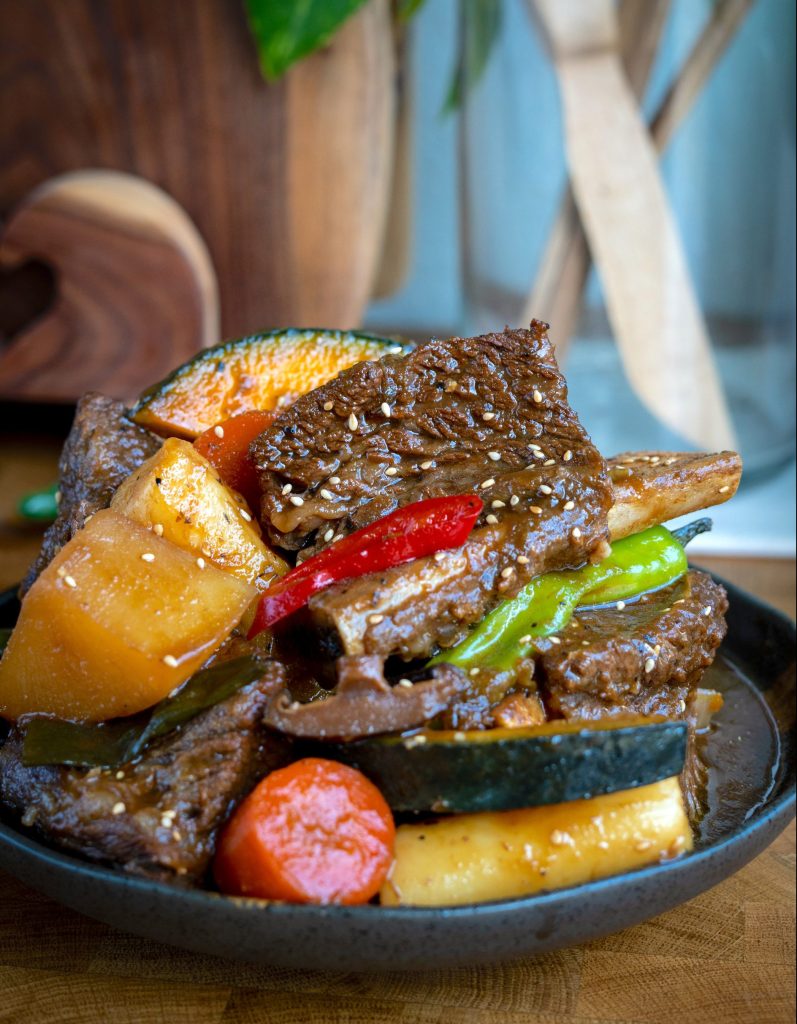
Galbi jjim is a Korean household FAVORITE. These soy braised short ribs are soooo flavorful, tender, and one of the best representations of Korean food in my opinion.
I’ve eaten and made galbi jjim many many times, but the best galbi jjim has always been from any Korean restaurant that specializes in it. Any time I made it at home, it just wasn’t as good as the restaurants. Why is that? No matter how many times I tested braising sauces and cooking methods, it just didn’t match the superiority of restaurant-made galbi jjim, until now!
In this post I will share everything you need to know about making the best restaurant-quality galbi jjim at home. You can find the recipe card with ingredients, measurements, and concise instructions at the bottom of this post. However, if you’d like a more in-depth explanation, please read through this entire post 🙂
Okay, let’s get started!
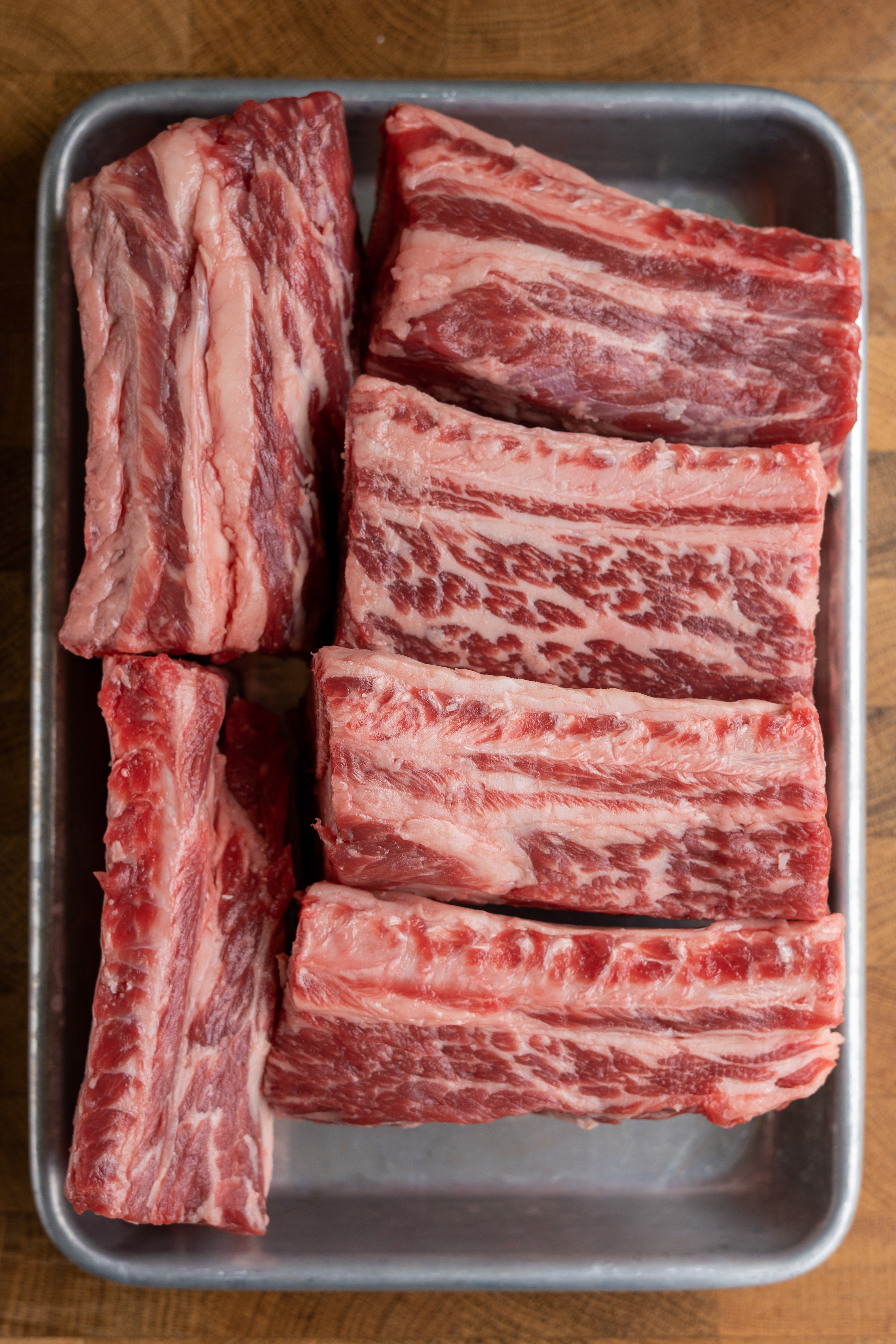
Ingredients:
- Beef short ribs- I HIGHLY recommend using prime grade short ribs. One of the reasons why restaurant galbi jjim tastes so much better than homemade is because they are using the best quality. Prime is MUCH more tender than choice- it has better fat marbling. The short ribs I got (picture above) have a little more fat than I would like, but you generally want to pick some with very good fat marbling. Fat = flavor!
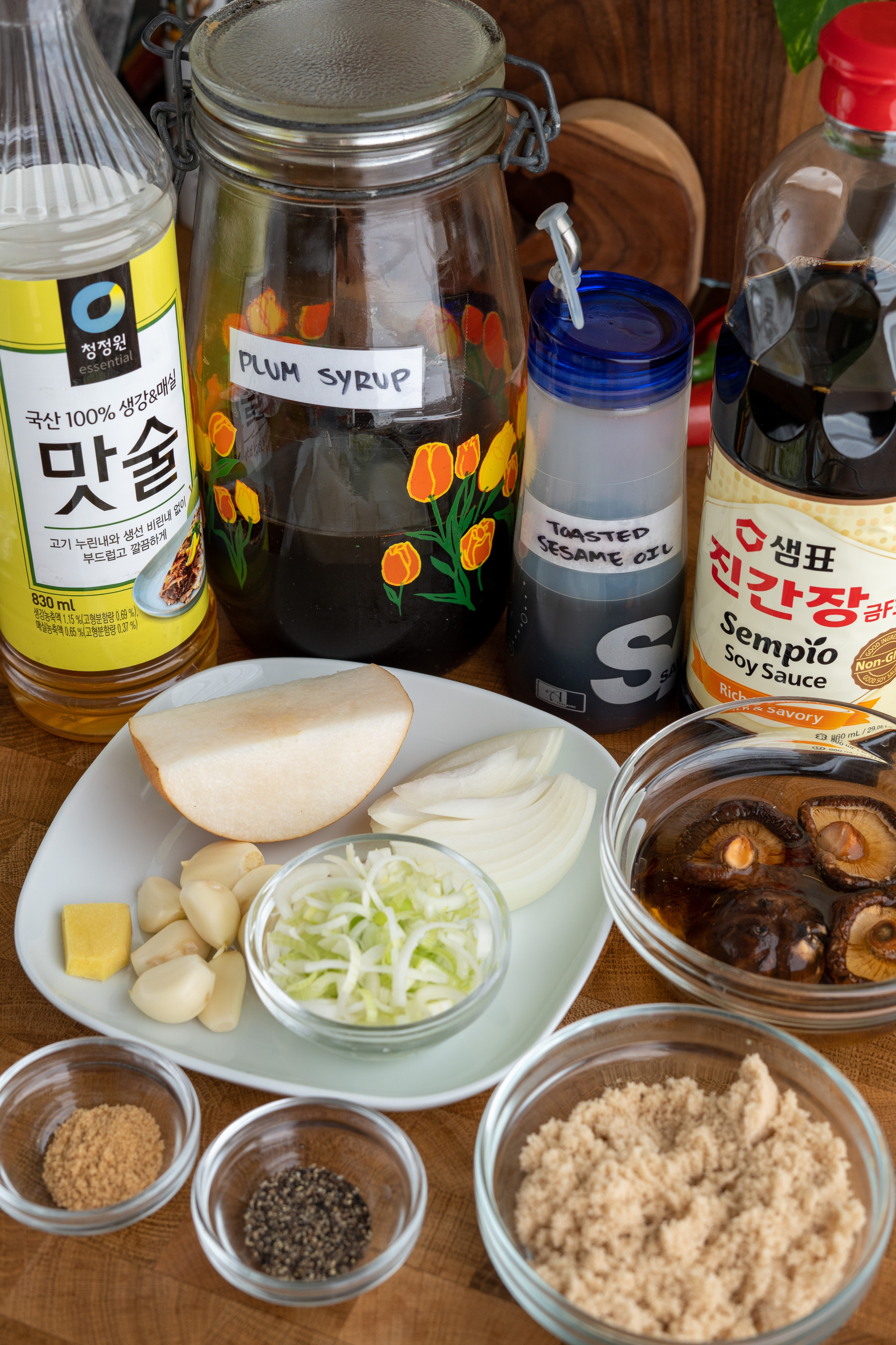
Ingredients (continued)
- Dried shiitake mushrooms- you may use fresh shiitake mushrooms instead if you want. I always have dried shiitake mushrooms in my pantry because they have a long shelf life, lots of flavor, and it’s not as wasteful as buying them fresh.
- Braising sauce- galbi jjim is supposed to be sweet & savory. My husband and I both generally do not lean towards the sweeter side on things, except for this dish! If you do not like it that sweet, I recommend dialing back the brown sugar a little bit.Here’s everything you will need:
- Soy sauce- my favorite soy sauce for braising is Sempio Jin Ganjang Gold F3. Don’t use soup soy sauce or dark soy sauce.
- Cooking wine- I use a Korean sweetened cooking wine called matsool, or more commonly known in the west as mirin (that’s the Japanese name for it). This product is specifically for removing gamey or fishy tastes in meat.
- Plum Syrup- the plum syrup I have is homemade but you can buy it from any Korean market. Is it absolutely necessary? It depends on your taste preference. You could easily replace plum syrup with corn or rice syrup, but the finished flavors won’t be as well-rounded in my opinion.
- Shiitake dashi- this is the soaking water from the dried shiitake mushrooms. It adds umami to the braising sauce.
- Brown sugar- most Korean recipes for galbi jim use light brown sugar, but you can use any kind of sugar you have. White sugar is perfectly fine.
- Garlic, onion, Korean pear, & ginger puree- this puree is commonly added to the braising sauce or marinade for LA galbi. It helps to tenderize the beef, while also adding flavor. Garlic is a must for this braising sauce, and the Korean pear also lends a little natural sweetness.
- Black pepper
- Large green onion- thinly chopped, just the white parts for the braising sauce and the rest as a garnish.
- Dashida- this is optional but highly recommended. It is not really a traditional ingredient for galbi jjim, but this is how restaurants make their galbi jjim taste extra delicious. Dashida is Korean beef bouillon that has msg in it, which is a flavor enhancer. It is a staple ingredient in many Korean kitchens.
- Veggies- all of these are needed for galbi jjim. The only ingredient you can leave out here is the red chili pepper if you don’t want any heat, but it also adds some flavor.
- Korean radish
- Large green onion
- Onion
- Red chili pepper
- Optional add-ins
- Rice cakes– I just love rice cakes covered in the galbi jjim braising sauce and it also helps to thicken it a little bit.
- Shishito pepper– not traditional, but I love shishito peppers with galbi jjim. I also add it to my jang jorim (soy braised beef side dish).
- Kabocha or potato- if you like starchy veggies, definitely add either kabocha or potatoes. When braised in the sauce, it absorbs so much of the flavor and they are soooo soft and delicious!
- Jujubes- these are a traditional ingredient for galbi jjim, but I don’t usually add it unless I already have some.
- Ginko nuts- these are also traditionally added to galbi jjim, but not something that is a must for me.
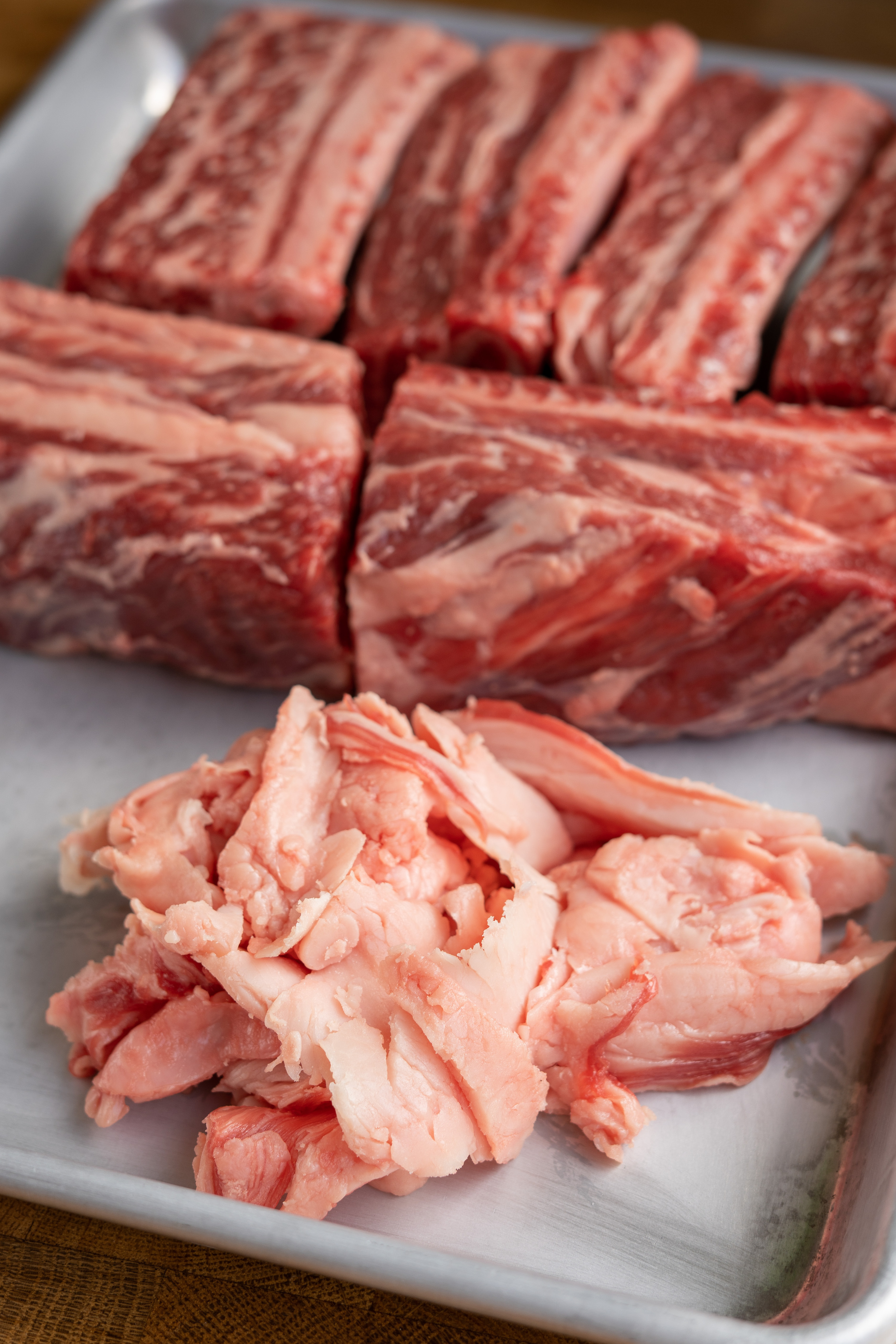
How to make it
Here are very detailed instructions with photos for your reference. Please refer to the recipe card at the end of this post for the ingredient measurements and simple instructions.
1. Trim off any excess fat. You can remove the membrane if you want, but I leave them on for two reasons:
- My husband actually likes to eat the membrane. It’s chewy, and can be a little tough in comparison to the beef. But I still eat it too, as it does take on the braising sauce flavors and isn’t un unpleasant texture to me, but that is not the case for most people.
- The finished dish looks prettier when the bone is still attached. If you remove the membrane, the meat will fall off the bone which is totally fine, but for presentation purposes only I prefer the bone to stay attached.
If you don’t care about either of these things, go ahead and remove the membrane.
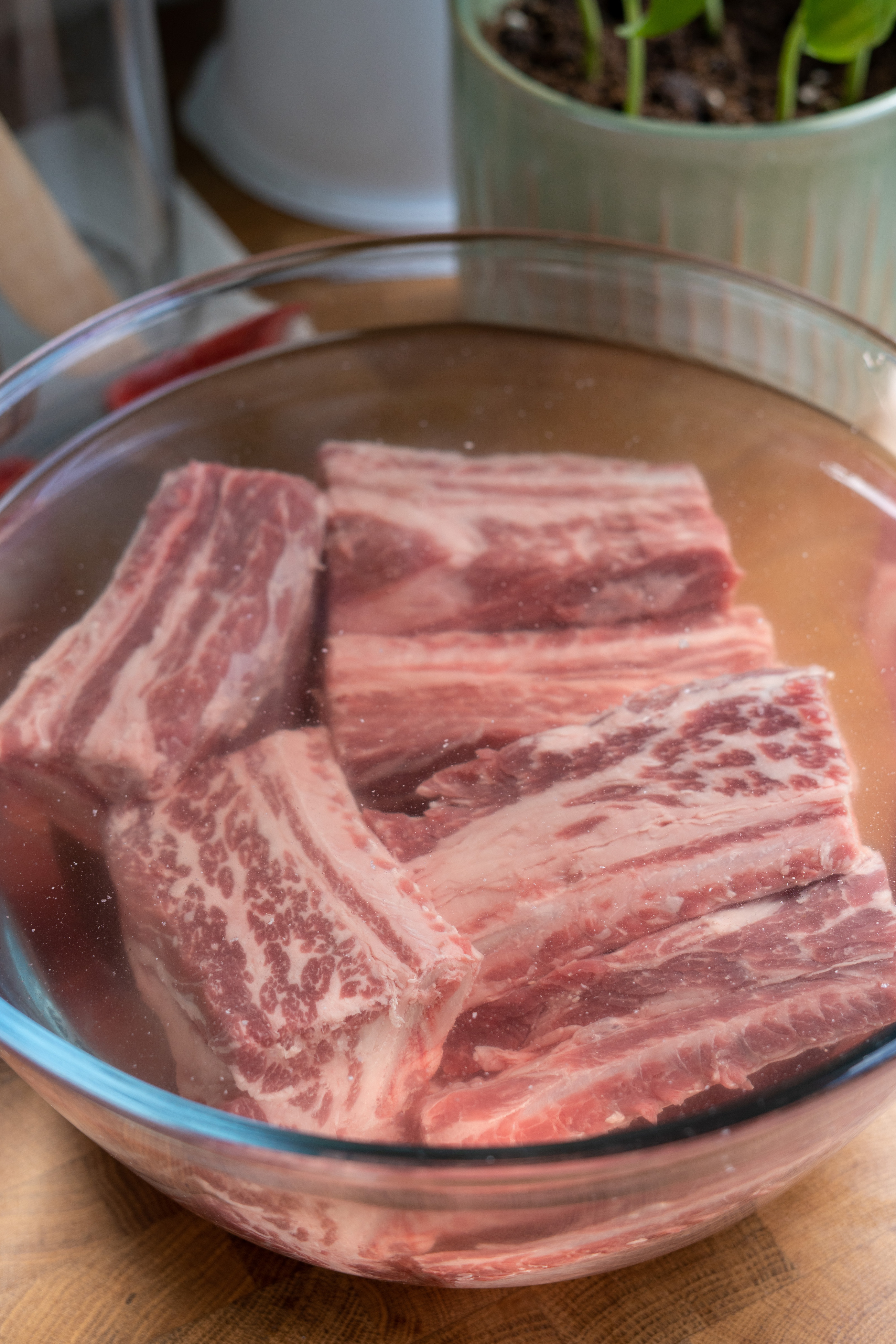
2. Soak the short ribs in cold water for at least 2 hours, changing the water half way through. You may soak them overnight in the fridge as well.
I grew up being taught that this draws out unwanted blood from the meat and bones, which helps to get rid of excessive & unpleasant beefy flavors . I know someone will correct me and say its not blood, it’s actually myoglobin, which is true. Yet, every Korean chef I know still refers to it as blood and says it needs to be removed as much as possible.
Truthfully, I don’t know the exact reason why Koreans go through such great lengths to remove “blood” from meat. I’ve done a little research on this, and I think it may be tied to just holding onto an old cooking tradition when it was necessary because of the low quality of beef in Korea.
All I really know is that Asians in general have a strong distaste for meats that have a heavy gamey/meaty taste and smell, so soaking red meat in water is a very common practice to help with this. But this is not the only thing that is done- you’ll see in step 7.

3. Soak some dried shiitake mushrooms in hot water for 30 minutes.
You may use fresh shiitake mushrooms instead if you want. I always have dried shiitake mushrooms in my pantry because they have a long shelf life, lots of flavor, and it’s not as wasteful as buying them fresh.
*Do not throw out the soaking water when done.

4. Meanwhile, prepare the veggies/additional ingredients if using
- Let’s start with the must haves:
- you definitely need Korean radish to make galbi jjim. You don’t necessarily need the carrots, but if you’re going to use them, cut them bigger than the Korean radish. Same for potatoes.
- You also need large green onion and regular onion- cut these into large pieces like in the photo above. Another essential ingredient is the shiitake mushrooms. After they are rehydrated from soaking in water, squeeze out the moisture and cut them in half.
- Everything else is optional and based on my personal taste. I love rice cakes in anything, especially grilled or covered in sauce so I add it to my galbi jjim. It also helps to thicken the braising sauce at the end.
- I don’t always add jujubes, but I actually had a couple so I added them. I love shishito peppers in it as well. The kabocha is one of my favorite additions to galbi jjim, but if I don’t have this at home then I’ll usually add potatoes instead.
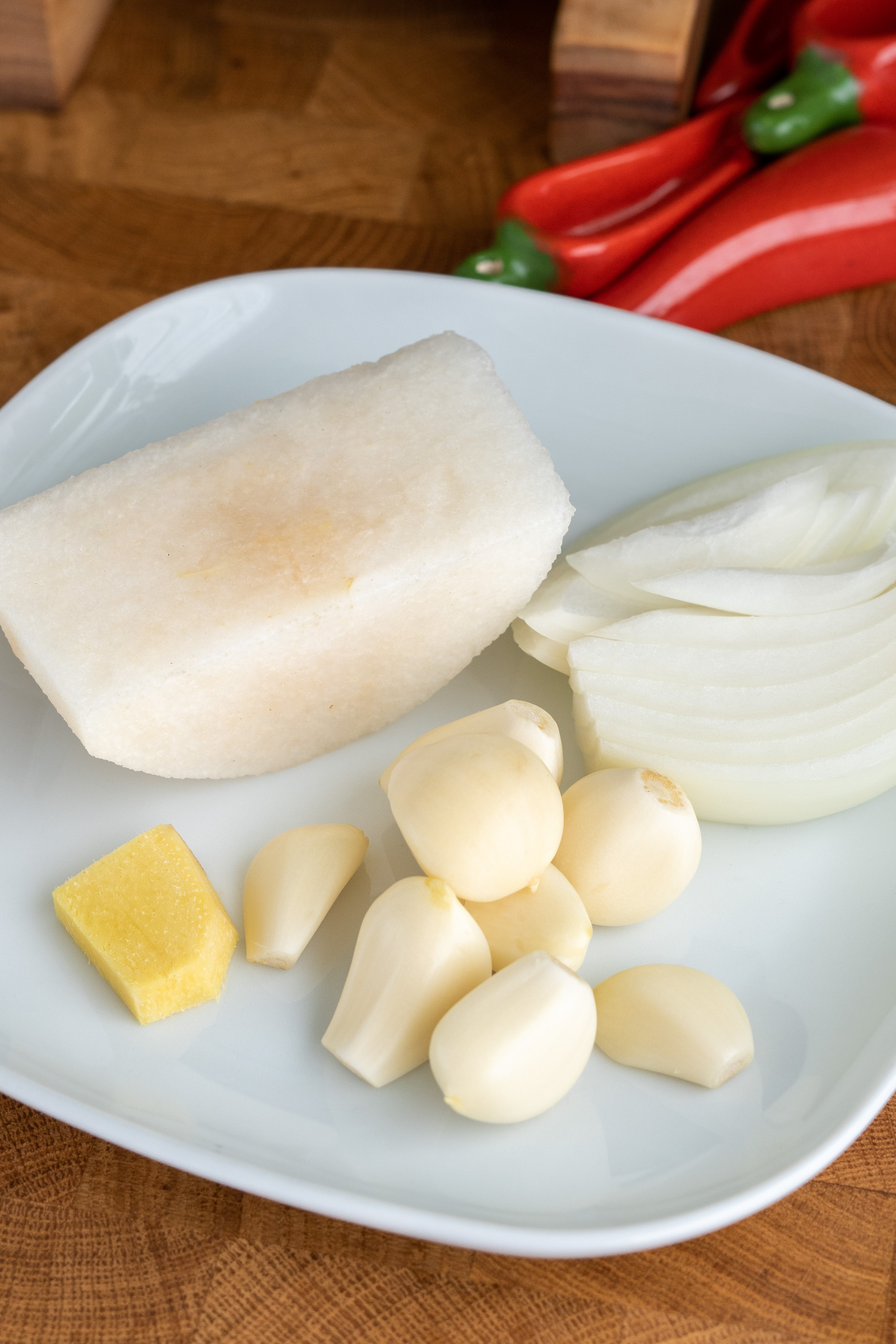
5. To a blender add Korean pear, onion, garlic, and a little ginger. Process until you have a smooth puree.
If you can’t find Korean pear, you can use bosc pear instead. It helps with tenderizing the meat and also adds some natural sweetness to the sauce.
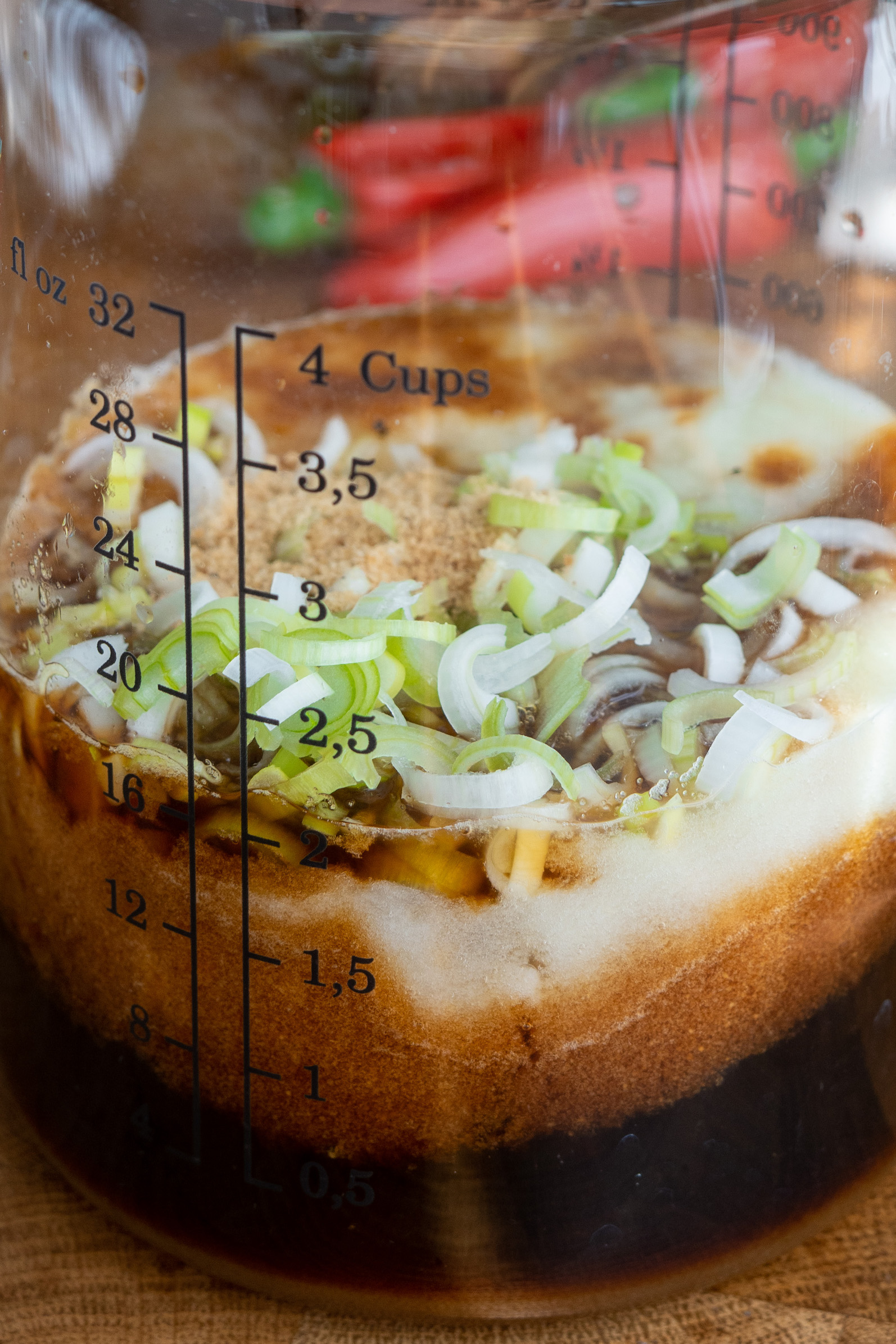
6. Combine the puree with soy sauce, light brown sugar, the shiitake soaking water (dashi), Korean cooking wine (matsool), plum syrup, black pepper, and chopped large green onion. Dashida is optional but highly recommended. It’s Korean beef bouillon, which has msg (yum!)
If you want to make the spicy version of galbi jjim, you can add gochujang (Korean red pepper paste) and gochugaru (Korean red pepper flakes).
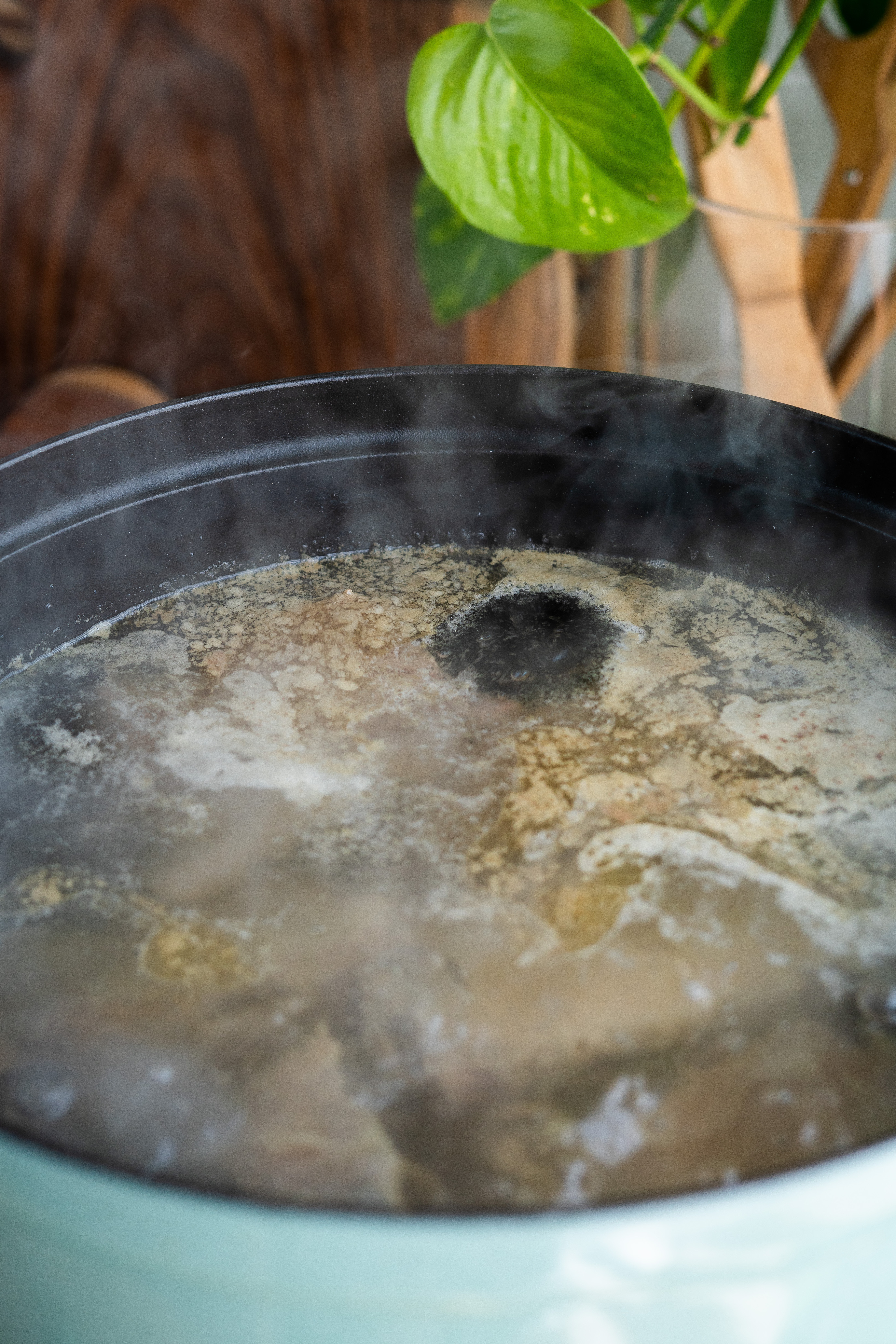
7. Fill a pot with room temperature water then add the short ribs and bring it to a boil. Once it starts to boil, cook for 4-5 minutes.
Parboiling meat is a technique used in many Asian cuisines to remove fat and impurities.
To parboil meat the correct way, it needs to be brought to a boil with the meat in cool water. Do not put the meat in water that is already boiling.
It will take about 15 minutes for it to start boiling, but before that you will start to see the scum floating to the surface. Skim it off. Once it starts to boil, you only need to let it boil for 4-5 minutes. In total it will take about 15-20 minutes.
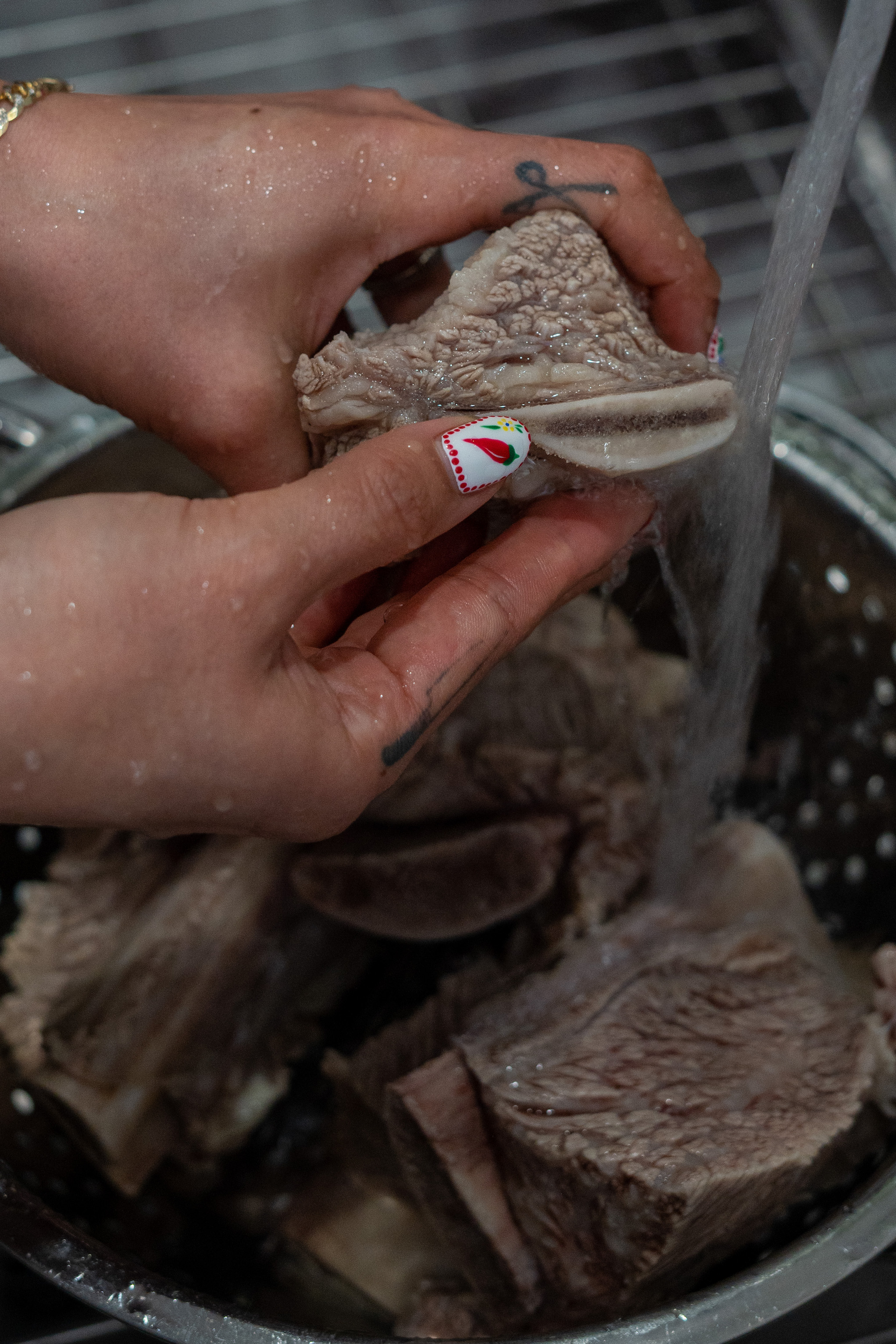
8. Strain the broth into a large bowl and set it aside. Thoroughly rinse the short ribs under cold running water.
There will be lots of scum and possibly bone fragments from being cut by the butcher. Make sure you remove it all so we have a nice clean dish
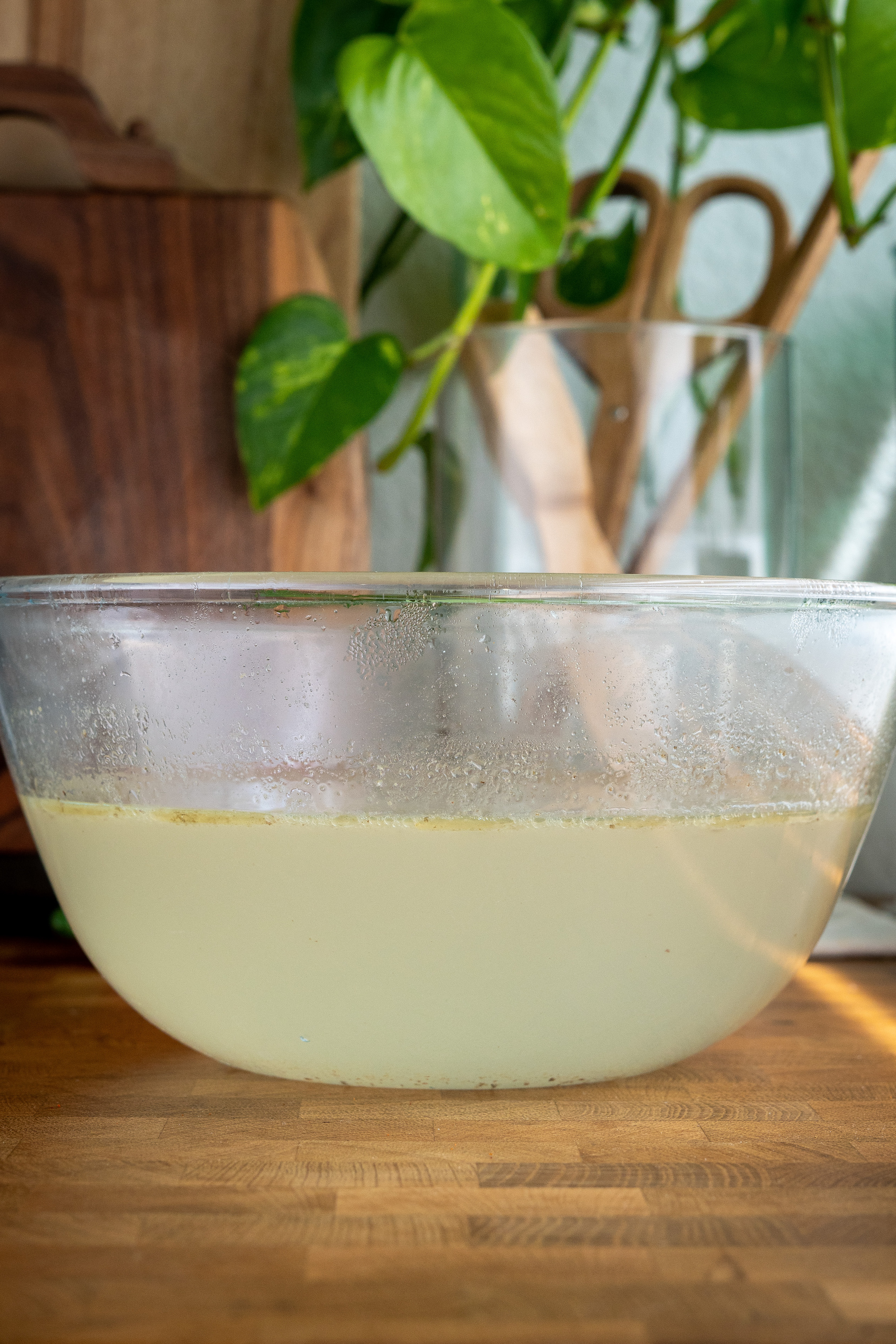
9. The beef broth that was set aside needs to be filtered and the fat removed.
You can either wait for the fat to solidify on top (but that takes time), or you can use a fat separator. You need to reserve about 5 cups (you only need 3, but keep some extra just in case).
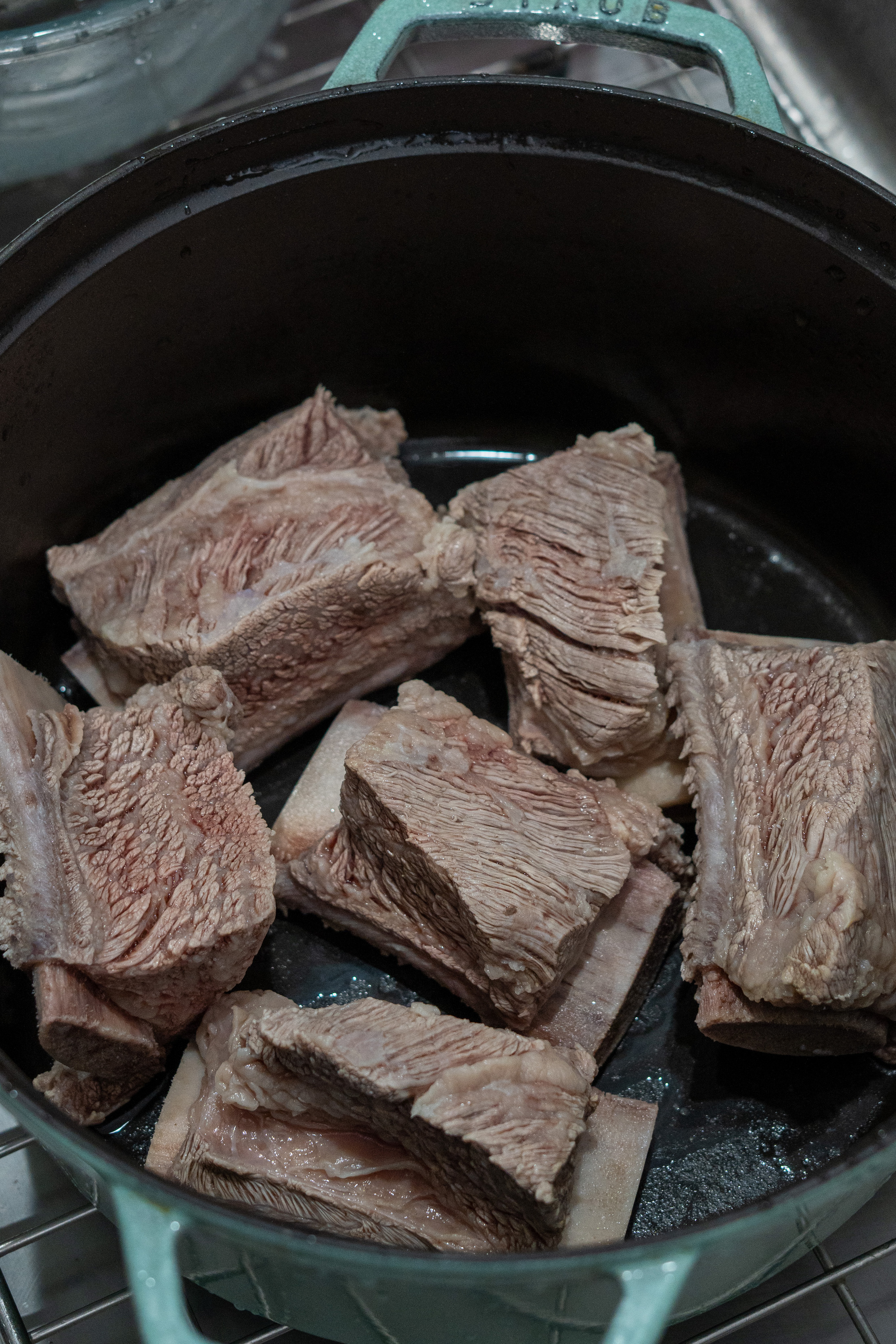
10. Add the cleaned short ribs back into the pot.
Clean the pot first so there are no scum remnants floating around.
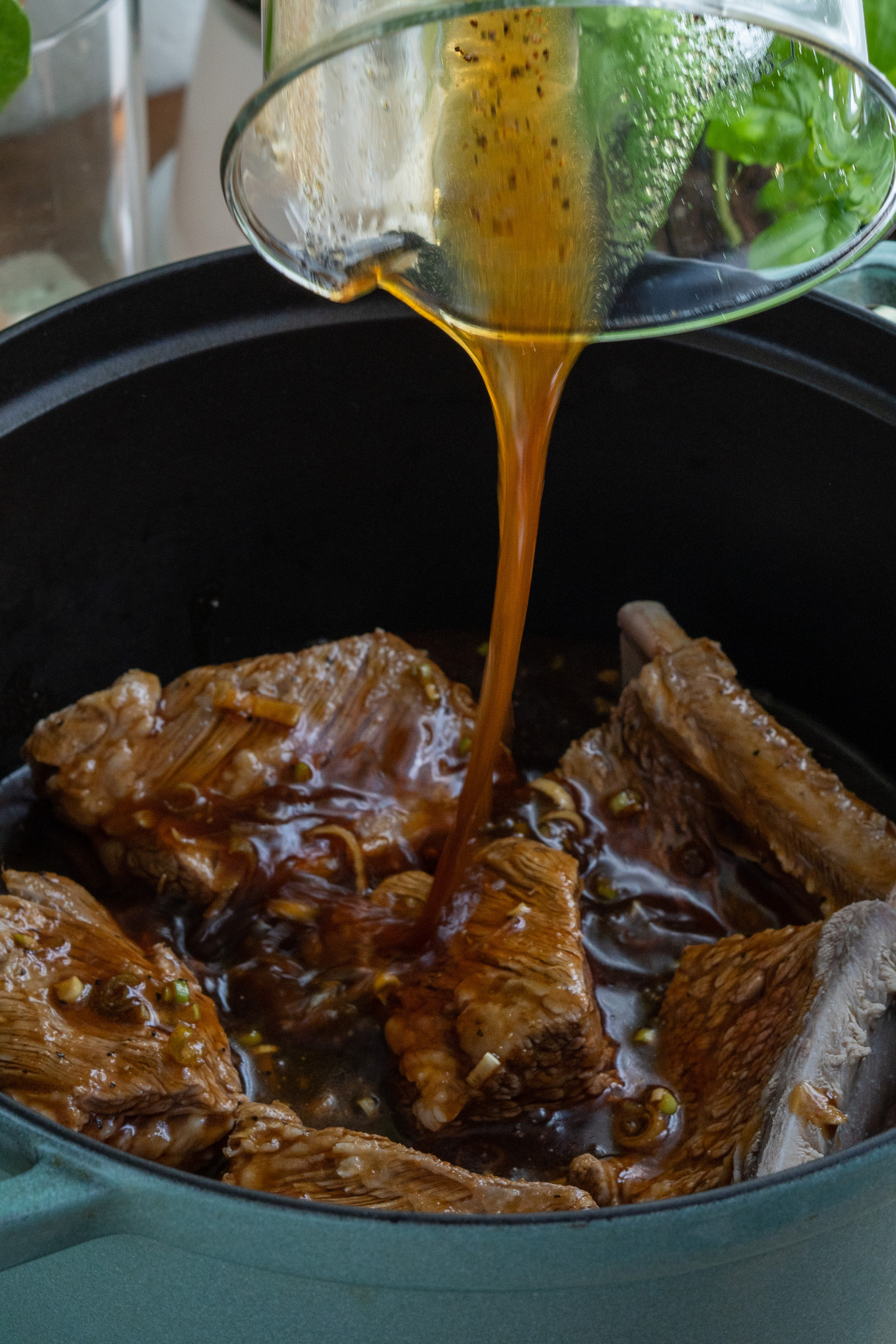
11. Cover the short ribs in the braising sauce
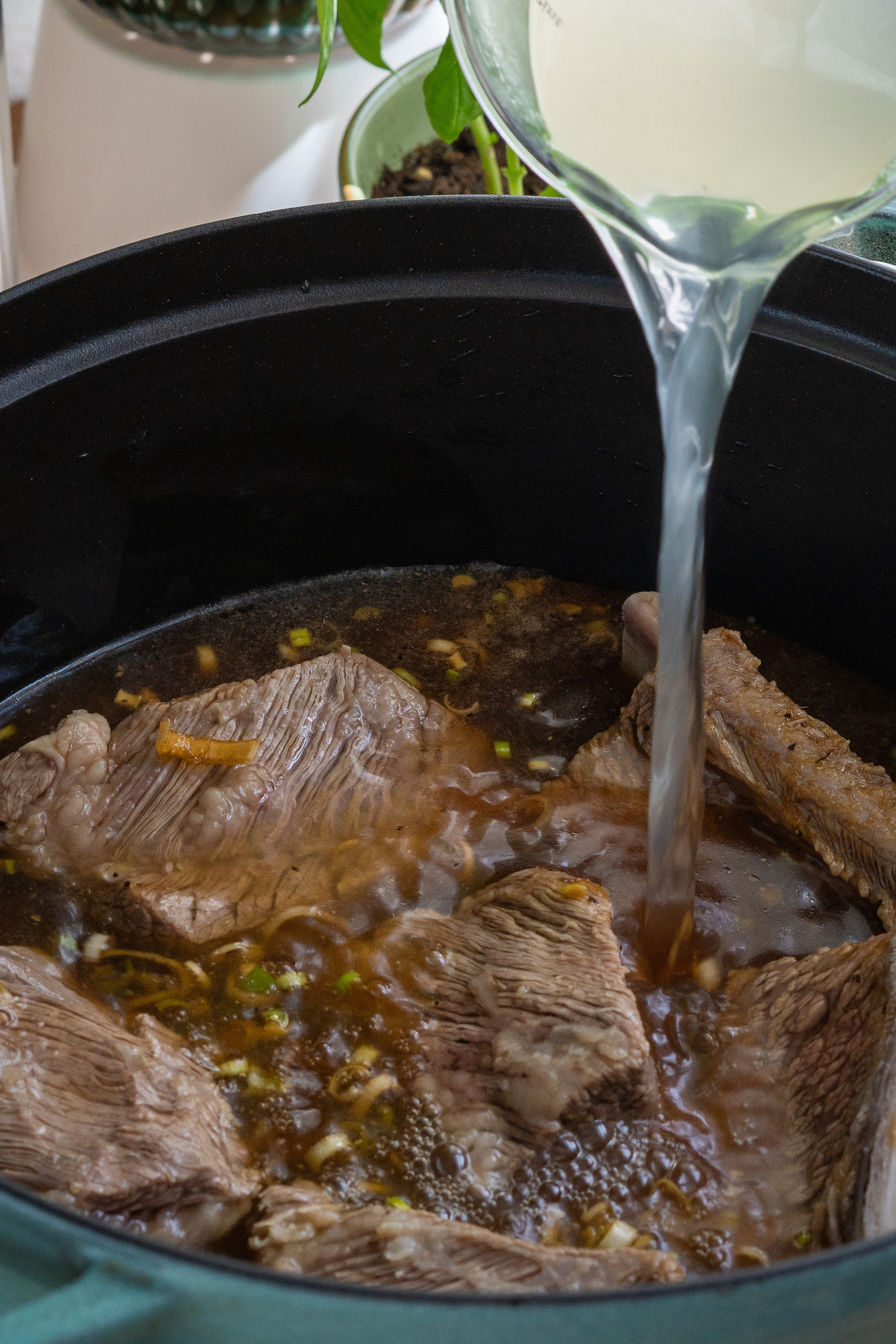
12. Then add about 3 cups of the filtered beef broth.
The short ribs should be about 80% covered in liquid, NOT all the way. Add less or more broth as needed.
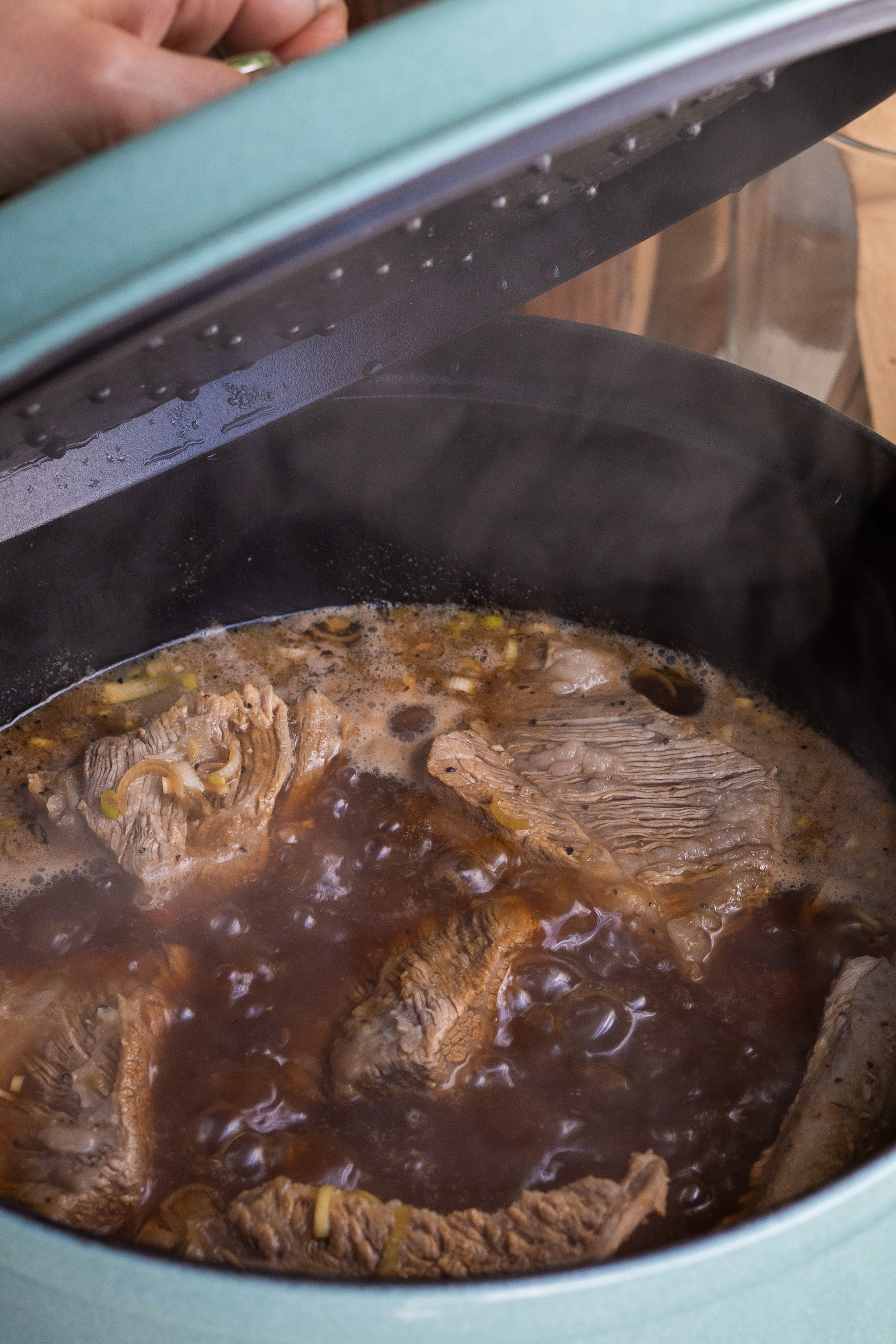
13. Bring to a boil, then reduce the heat to medium low and COVER for 1 hour, stirring occasionally.
Please refer to the photo above for the strength of the heat. Do not use high heat to braise meat. It should be a gentle boil- medium lowish heat for tender beef that won’t shrink too much in size.
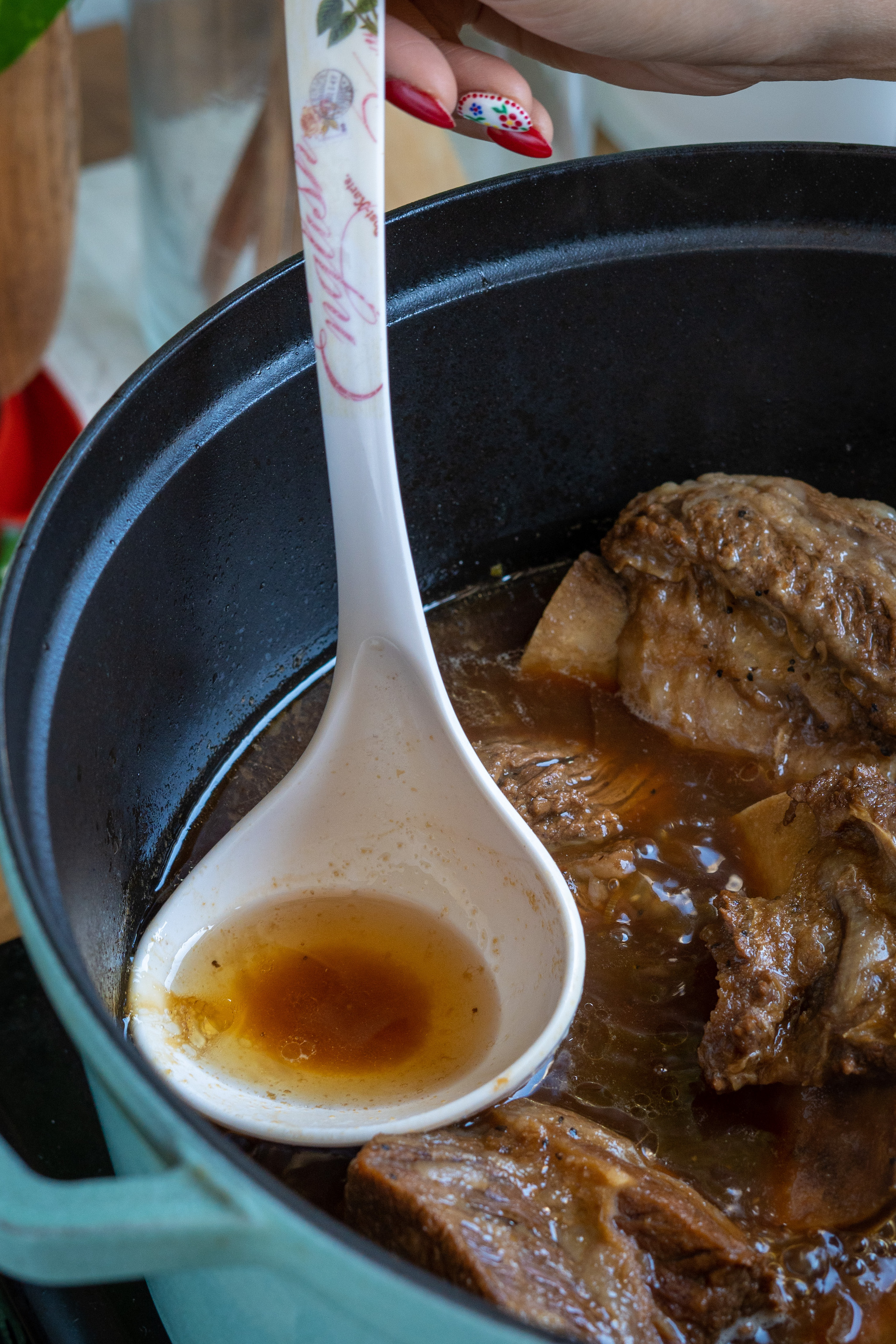
14. After 1 hour, skim off as much fat as you can.
Use a spoon or ladle on the sides of the pot to collect fat, little by little. Don’t worry if you can’t get it all out. A little fat is ok.
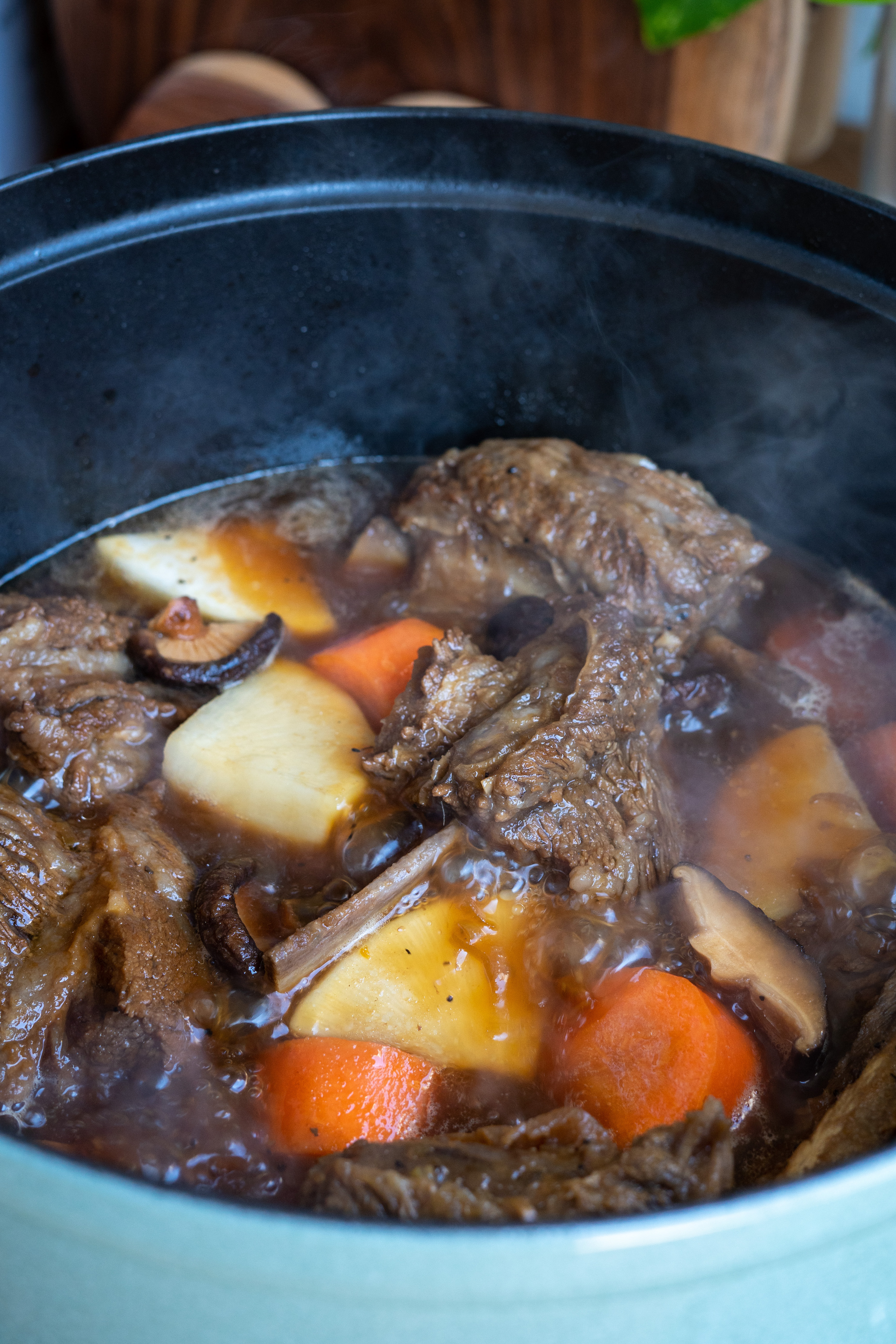
15. Add the Korean radish, carrots, potatoes, and rehydrated shiitake mushrooms. COVER and continue to braise on medium low heat for 30 minutes, or until the Korean radish is chopstick tender.
If too much of the liquid has reduced, you can add a bit more beef broth to keep the short ribs submerged by at least half. Make sure everything you just added is also submerged in the braising sauce.
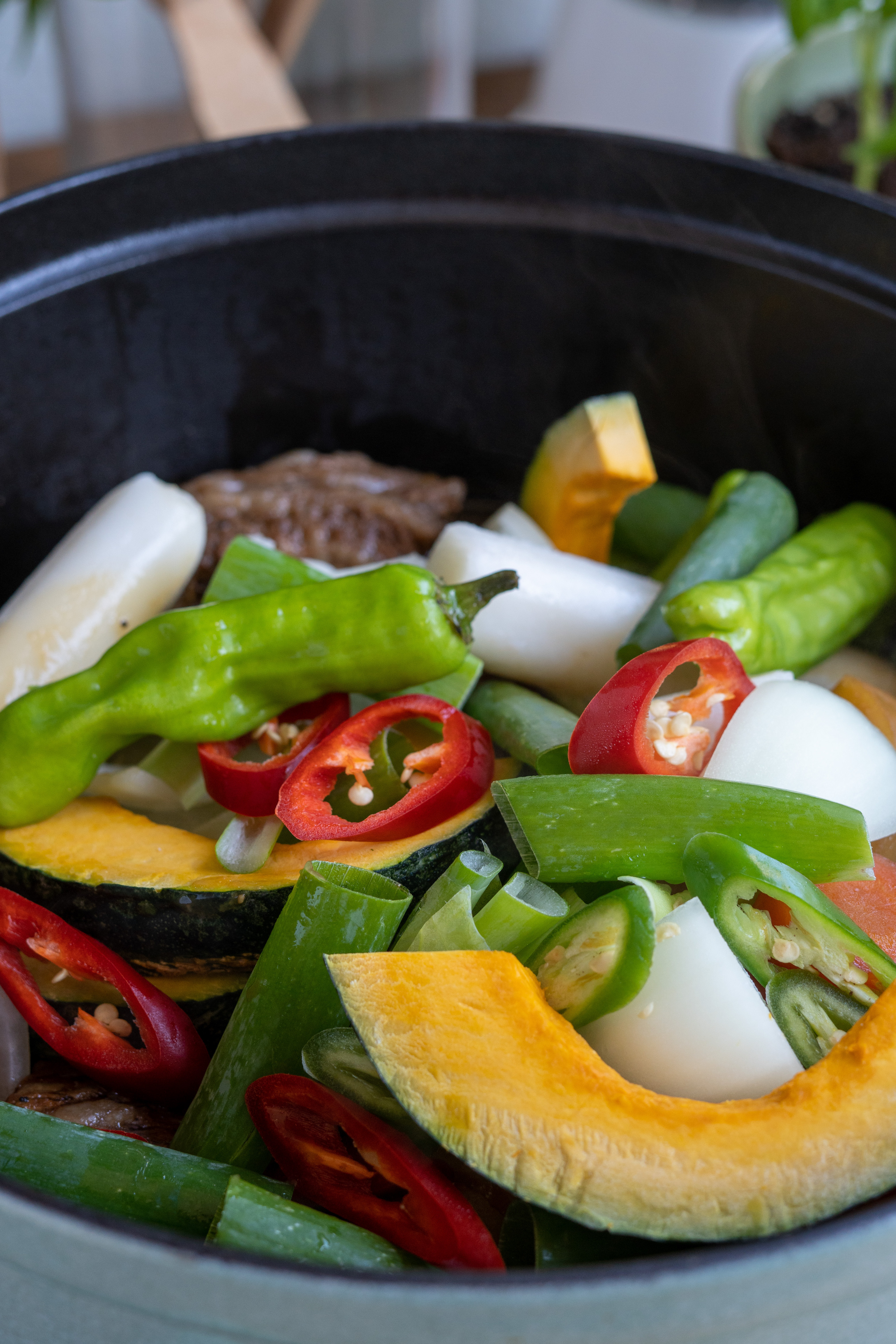
16. Increase the heat to medium high and add the onions, large green onion, and red chili pepper. Toss to coat in the sauce and cook for 15 minutes UNCOVERED. The sauce will reduce and thicken a little bit.
I also like to add shishito peppers, kabocha, and rice cakes but these are optional.

17. Garnish with sesame seeds and serve with rice and kimchi!
And that’s it!

What to eat with Galbi Jjim
For me, galbi jjim MUST go with rice and kimchi.
Any kind of kimchi will compliment galbi jjim very nicely. If you want something that’s quick and easy to make, I highly recommend either my bok choy kimchi salad or cucumber kimchi salad!
I’ve noticed a rise in popularity of cheese on galbi jjim lately. I personally don’t like this combo but if you want to make cheesy galbi jjim, just add some shredded mozzarella on top and put it under a broiler for a couple minutes.
Tips for making the best galbi jjim at home
- Use high quality short ribs! Prime grade short ribs are best. Make sure it has plenty of fat marbled throughout, but remove any excess fat on the outside.
- Don’t skip the soaking, parboiling, or rinsing steps. Doing so will result in a not-so-clean-tasting dish.
- Use a pot that is at least 10 inches in diameter, but 12 would be better. This ensures that every piece of short rib is being braised in the sauce, and gives you enough room to gently mix in all the other ingredients.
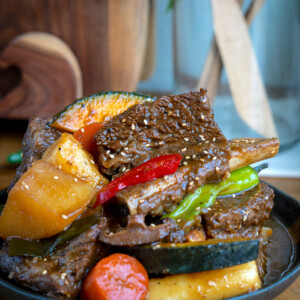
Galbi Jjim- Korean Braised Short Ribs
Ingredients
- 4 lbs prime short ribs
- 1/2 lb Korean radish
- 1 carrot
- 1 large green onion
- 1/2 large onion
- 4 dried shiitake mushrooms
- 1 red chili pepper
- 1 tsp sesame seeds, for garnish
- 3 cups reserved beef broth
Braising Sauce
- 2/3 cup soy sauce
- 1/4 cup light brown sugar, add more if you like it sweet
- 2 tbsp plum syrup
- 1/3 cup shiitake mushroom soaking water
- 1/4 cup mirin
- 8 cloves garlic
- 1 tsp ginger
- 2 oz onion
- 3 oz Korean pear
- 1 tsp dashida, beef bouillon- optional
- 1 tsp black pepper
- 1 tbsp sesame oil
- white part of large green onion, chopped
To make spicy galbi jjim, add these to the braising sauce:
- 2 tbsp gochugaru, Korean red pepper flakes
- 3 tbsp extra spicy gochujang , Koren red pepper paste
Optional add-ins
- shishito pepper
- rice cake
- kabocha or potato
- jujubes
- ginko nuts
Instructions
- Soak the short ribs in cold water for 1-2 hours, changing the water once or twice.
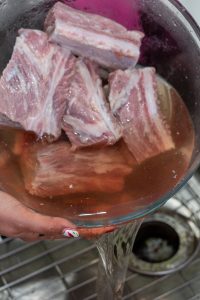
- Soak some dried shiitake mushrooms in hot water for 30 minutes.
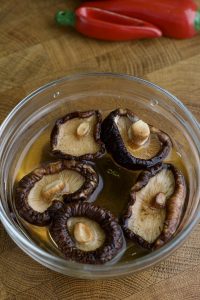
- Prep your veggies: If using carrots & potatoes, cut them into bigger pieces than the Korean radish. Slice the chili pepper, cut the onion into large chunks, thinly slice the white part of the large green onion and cut the rest into thick strips.
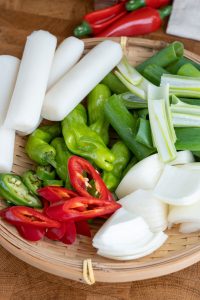
- Combine garlic, onion, Korean pear, and ginger and blend until smooth.
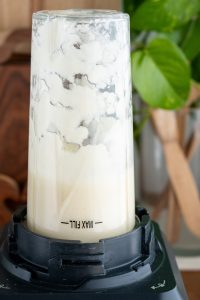
- Combine the puree with soy sauce, light brown sugar, mirin, the shiitake soaking water, plum syrup, black pepper, sesame oil, the white part of a large green onion, and dashida (Korean beef bouillon- optional).
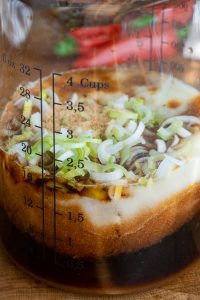
- Fill a pot with cool water then add the ribs. Bring it to a boil- once it starts to boil, cook for 4 to 5 minutes. It will take 10-15 minutes for it to start boiling. Remove scum that floats to the surface.*Use a deep pot that is at least 10 inches in diameter, but 12 inches would be better.
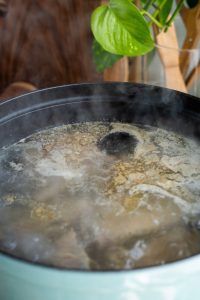
- Strain the broth into a large bowl and set it aside.
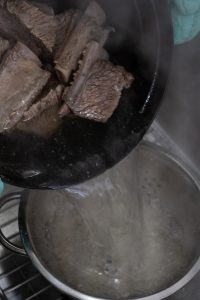
- Thoroughly rinse the short ribs under cold running water. There will be lots of scum and possibly bone fragments from being cut.
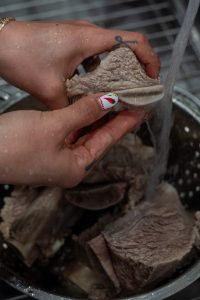
- Filter the beef broth that was set aside. Reserve about 5 cups (you only need 3, but keep some extra just in case).
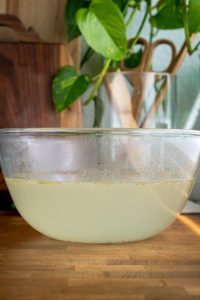
- Add the cleaned short ribs back into the cleaned pot.
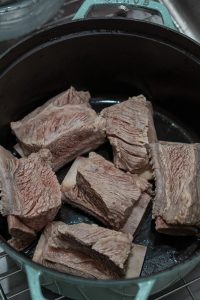
- Cover in the braising sauce
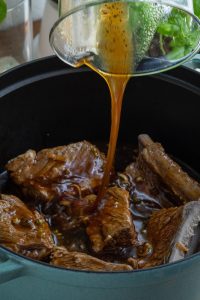
- Then add about 3 cups of the beef broth. The short ribs should be about 80% covered in liquid, NOT all the way. Add less or more broth as needed.
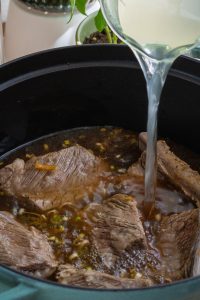
- Bring to a boil, then reduce the heat to medium low and cover for 1 hour, stirring occasionally.
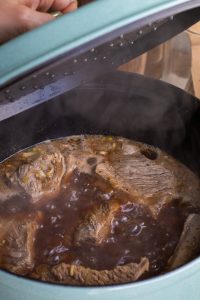
- After 1 hour, skim off as much fat as you can.
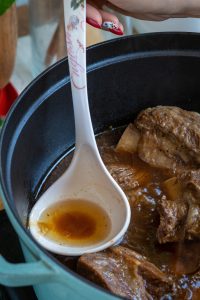
- Add the Korean radish, carrots, potatoes and rehydrated shiitake mushrooms. Cover and continue to braise on medium low heat for 30 minutes, or until the Korean radish is chopstick tender. If too much of the liquid has reduced, you can add a bit more beef broth to keep the short ribs submerged by at least half.
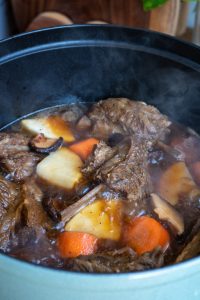
- Increase the heat to medium high and add the onions, large green onion, and red chili pepper. I also like to add shishito peppers, kabocha, and rice cakes but these are optional. Cook for 15 minutes UNCOVERED. The sauce will reduce a and thicken a little bit.
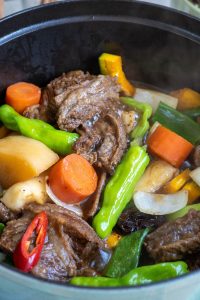
- Garnish with sesame seeds and serve with rice and kimchi! This goes best with my mom's bok choy kimchi or cucumber kimchi 🙂
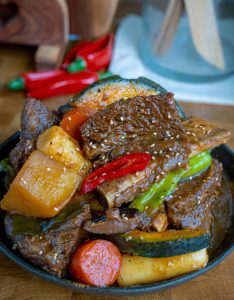
Nutrition information is automatically calculated, so should only be used as an approximation.
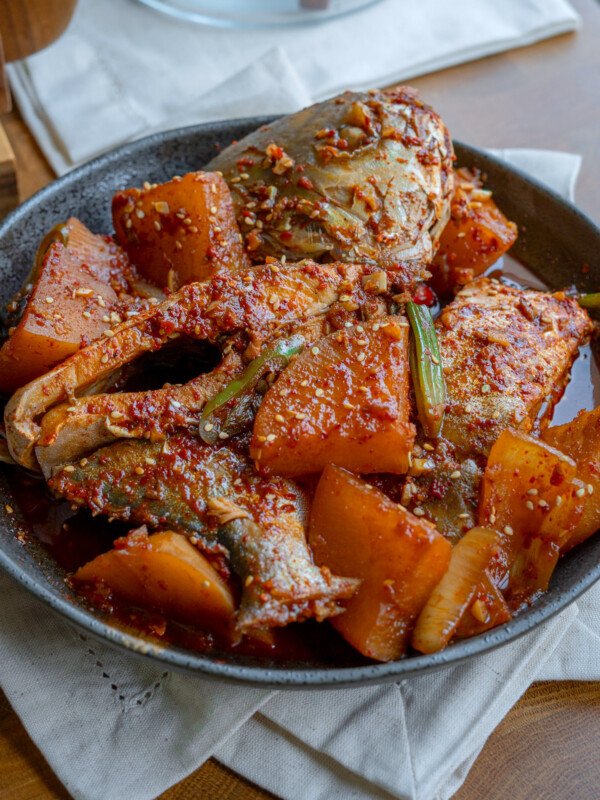
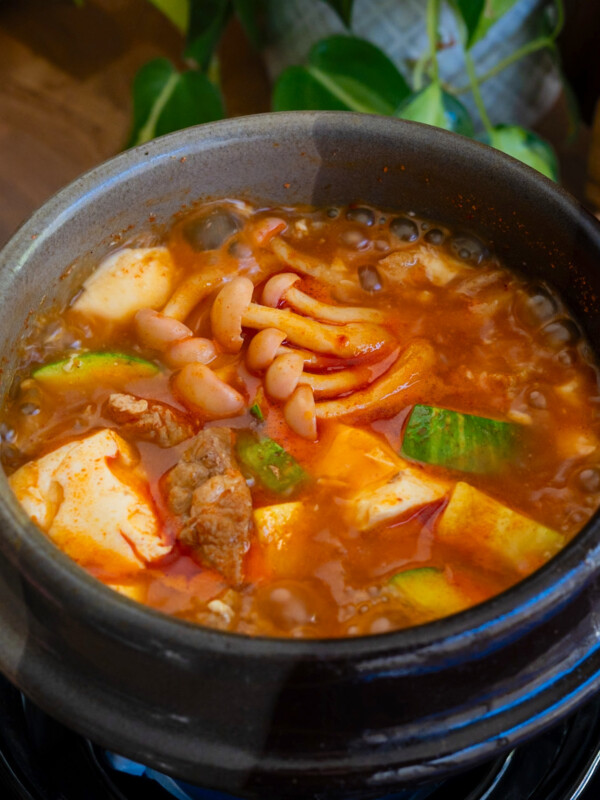
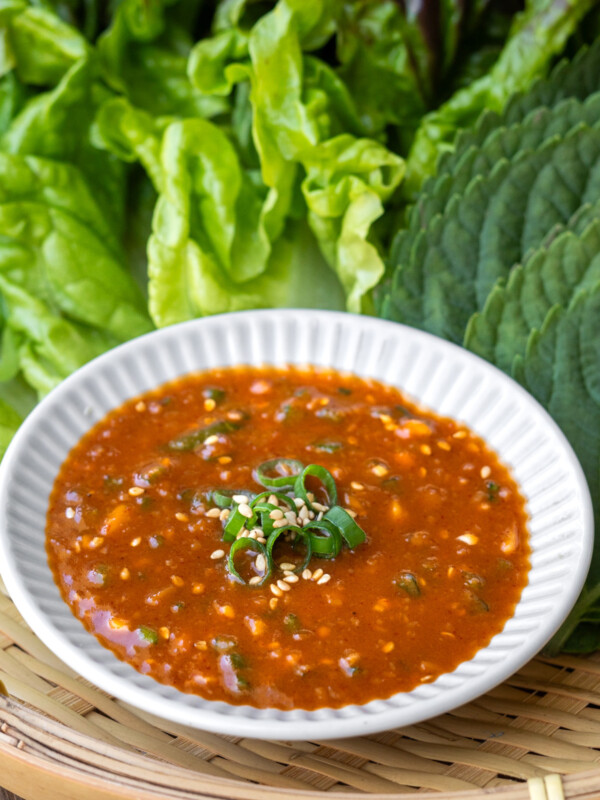
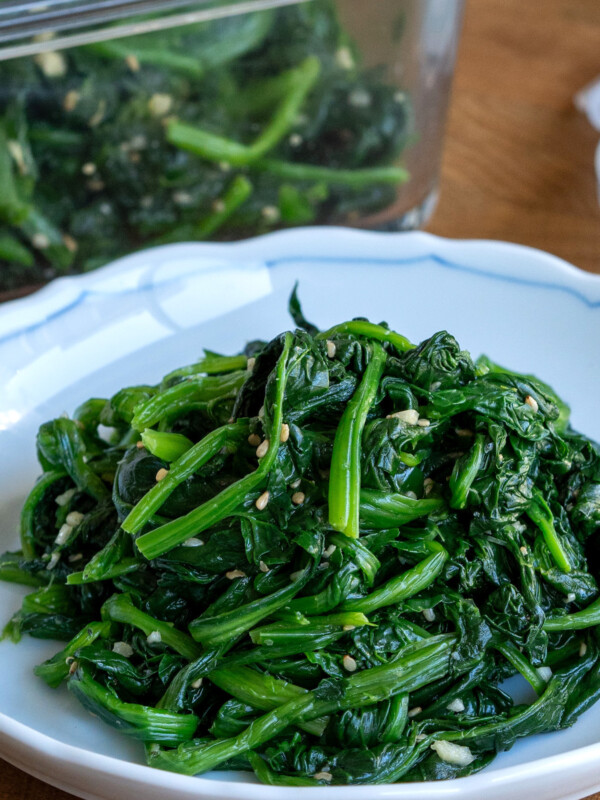







Galbi jjim is one of my favorite Korean dishes and it was my first time making it from scratch following your recipe. I’ve always thought it was a complicated dish to make, but your recipe was easy to follow and it came out AMAZING! Definitely one of my fav recipes from you.
Thanks so much
This is one of my favorite Korean dishes that is also super expensive at restaurants. This recipe is super detailed and easy to follow. I made mine with rice cakes instead of potatoes. The chewy texture really adds to the whole dish!
I made this for my mom and she loved it! Thanks!
I always come back for this recipe and love that you recommended kabocha
Whenever I crave for galbi, this is the recipe I follow and smacks every time!
Tried this recipe not too long ago and it was absolutely delicious !! Thank you!!
I made this for date night and it was such a hit. Will definitely make it again!!
This is such a comforting dish for me and I’m so glad you have the recipe for it! The flavors melt so well together, I love making this at least once a month!
Gal bi jim is one of my husband’s favorite meal! I was never able to find the perfect recipe to satisfy my husband’s taste until I found yours! I even made this for Christmas this year when I invited my in-laws over. Thank you so much for being so detailed with very specific steps. I am a very by the book follower so this recipe was perfect!
I try to follow it as you write it bc I trust your recipes!! I know whatever you post will be good!! Thank you!! And this is unrelated but you are freakin gorgeous. Love your style. Do a blog on that. 🙂
I already left a comment before (which I never do for recipes) but I went from never making galbi jjim ever (I’m 45 now) to making it already 3 times in the last couple months. 🙂 I’ve loved the few recipes I’ve tried and know I can trust your measurements and suggestions! I always feel like I have to tweak recipes but you are not only gorgeous, your recipes are great!!
Thank you for sharing them with us!!
I made this and followed the ingredient list and measurements closely. The two main differences were that I substituted extra brown sugar for plum syrup, and I used regular beef back ribs instead of short ribs. I was worried that regular ribs would take longer to cook, so I used an electric pressure cooker for 30 minutes and reduced the sauce afterwards. Came out amazing! It tasted exactly like the galbi-jim from one of my favorite restaurants (Daeho, a bay area restaurant), and the meat was very tender. I highly recommend this recipe to anyone, and I can tell how much care and attention went into this recipe. The flavors were very balanced, the perfect amount of sweetness and umami. I also had some bok choy, so I made the bok choy muchim recipe. That was also a knockout, and complemented the galbi-jjim really well. 10/10!
Hi Ashley, thank you so much for your detailed review! I am so glad you made the bok choy muchim to pair with it. It really does compliment the galbi jjim so well.
Didn’t know about plum syrup, dashida, or pear. I have to make it with jujubes though. I guess I could see it being too sweet with jujubes, plum syrup, and pear.
Nice job! looks delicious. Except it’s Spring so probably won’t try to make this until Winter again.